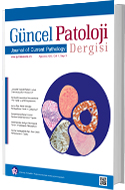2Izmir Katip Celebi University Ataturk Training And Research Hospital And Istanbul Koc University Hospital, Gastroenterology Clinic
Introduction: Curative endoscopic resection methods such as endoscopic mucosal resection (EMR) and endoscopic submucosal dissection (ESD) are new resection techniques that allow en bloc resection and treatment of superficial gastrointestinal lesions. We report a case of distinctive epithelial neoplasm of the esophagus resected with ESD which shows close resemblance to seborrheic keratosis, one of the most common benign epidermal tumors.
Case report: A 65 year-old patient’s previous endoscopic esophageal biopsy showed low grade dysplasia and the patient was referred to our hospital for ESD of a flat lesion in the mid-esophagus. Macroscopic examination revealed a well circumscribed, slightly pigmented and elevated plague-like lesion with a diameter of 20 mm. Alcian blue staining was used for delineation of mucosal margins and the specimen was serially sectioned perpendicularly at 2 mm intervals. All sections were subjected to histopathologic review. The lesion was well circumscribed, elevated plaque-like on low power magnification. On moderate power examination hematoxylin and eosin stained sections revealed hyperkeratosis, acanthosis, and papillomatosis. Broad coalescing solid sheets and interconnecting trabeculae of basaloid cells were the consistent feature throughout the lesion. Squamous eddies and occasional central keratinization were present. Mitotic activity and koilocytes were not identified. Immunohistochemically the lesion showed diffuse nuclear positivity with p63 and negativity with p16. Ki-67 labeling index was confined only to the basal cell layer of the lesion. With the help of histopathologic and immunohistochemical findings we diagnosed this morphologically benign case as a “seborrheic keratosis-like lesion of the esophagus”.
Conclusion: ESD is a safe procedure in the en-bloc resection of superficial esophageal lesions and it should be kept in mind that seborrheic keratosis-like lesions might be rarely seen on mucosal surfaces such as the esophagus. To our knowledge, this is the first case of the aforementioned lesion in the esophagus resected with ESD.
Anahtar Kelimeler : Endoscopic submucosal dissection, esophagus, seborrheic keratosis

